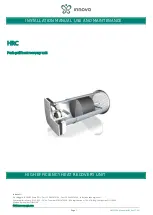
T E C H L I N E A S ™ D E S I G N G U I D E
NETAFIM @[email protected]
21/12/2009
36
5.2 Feed/Collecting Sub Mains
Dripperline grids will be serviced with a feed and collecting sub-main. All dripperlines will
connect to the feed/collecting sub-mains with Netafim Start Connectors. The feed sub-main will
be the same diameter as the collecting sub-main. All sub-mains shall be installed at the same
level or lower than the dripperline laterals
.
Ensure that all feed/collecting and lateral lines are
laid free of any kinks and adequately staked down to the soil. All sub-mains shall be sealed to
prevent dirt from entering at all times during installation. The sub-mains will be flushed out
thoroughly at least three times prior to any backfilling. Test for leaks prior to backfilling.
5.3 Air/vacuum Release Valves
Air/vacuum release valves are to be installed at the highest point on each drip station preferably
at the highest point on all feed and collecting lines. Locate the air/vacuum release valve in an
appropriately sized valve box which shall be free of any dirt or debris. Place gravel to a depth of
50mm in the bottom of the valve enclosure.
5.4 Flush Valves
Flush valves shall be the same diameter as the feed/collecting line and installed at either the
lowest or furthest point on all feed/collecting sub-mains. Install flush vales in an appropriately
sized valve box which shall be free of any dirt or debris. The contractor shall place gravel to a
depth of 100mm in the bottom of the valve enclosure to allow adequate drainage of water.
5.5 Dripperline Installation
Dripperline may be inserted directly into the soil either with a pipe plough or trencher.
Alternatively it can be laid on a prepared surface prior to back filling of soil or mulch to the final
grade. Where trenchers are to be used ensure that the dripperline is installed at a uniform depth
and when applying back fill ensure that it is clean and free of any rocks or debris. Also ensure
that the dripperline is staked down at regular intervals to ensure that drip laterals remain evenly
spaced and won’t move through backfilling.
It is also imperative that the dripperline is installed at a uniform depth throughout the system.
Ensure that all dripperline ends are sealed throughout installation to prevent any dirt from
entering the dripperline. Thoroughly flush the dripperline out at least three times prior to
checking the dripperline to ensure that there are no leaks from any fittings or any damage to the
dripperline. Dripperline maximum run length shall not be exceeded maximum run lengths set
out in Table 2
(page 11)
.
5.6 Record Flow Rate
Record the flow rate of each drip station to be used in future testing/maintaining of the drip
system. Each dripperline shall be flushed out thoroughly three times to ensure that the lines are
free of any dirt or debris and that the dripperlines are filled with water. Commence testing and
record flow rate. This data will serve as a record for future reference.
5 Easy Step Easy Guide:
A Netafim 5 Easy Step Easy Guide can be downloaded from the Landscape section
(
http://www.netafim.com.au/index.php?sectionid=355
) of the Netafim Australia website.
The 5 Step Easy Guide provides simple instructions and clear diagrams for the installation of a
basic drip system.
Slope
Direction relative to slope
up to 2%
Direction not important
more than 2%
Dripperlines perpendicular to the slope
more than 2%
Sub-mains run along the line of slope, perpendicular
to the dripperlines



































